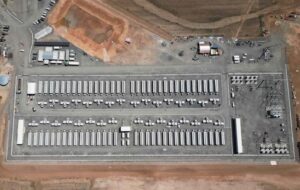Tesla is riding on the coat-tails of a phenomenal valuation at the moment – more than $US300 billion – largely based on investor views about the future of mobility. Those investors are convinced the future will be electric and autonomous, and they think that Tesla, for the moment, has an astonishing lead over its rivals.
Founder and CEO Elon Musk, however, says that these investors are overlooking one key part of his business – solar and battery storage – that he says could effectively double the value of the company. Or be worth as much, in itself, as the auto and e-mobility division.
“Tesla Energy will be up to roughly the same size as automotive,” Musk told investors on the company’s earnings call on Thursday morning (Australia time).
Read more on Tesla’s Q2 2020 result here: Tesla crushes rivals with first full-year profit
“So I mean, the energy business collectively is bigger than the automotive business. In order to achieve a sustainable energy future, we have to have sustainable energy generation, which I think is going to be primarily solar and …. followed by wind.”
“And batteries will play a key role to deal with the variability – when the wind doesn’t blow and the sun doesn’t shine. So there’s like three elements of the sustainable energy future – wind and solar, sustainable energy generation, battery storage and electric transport. Those three things.
“And the mission of Tesla is to accelerate sustainable energy.”
Right now, Tesla earns just a fraction of its revenue from battery storage and solar, despite installing what remains the biggest lithium-ion battery at the Hornsdale Power Reserve in South Australia (which is being expanded), and offering what Tesla claims to be the cheapest solar offerings in the US.
Its revenue from solar and storage was $US349 million in the last 12 months, less than one-tenth of the near $US5 billion earned from EV sales.
Leading analyst Morgan Stanley, in its “bull case” scenario for Tesla stock ($US2,200 a share), ascribed most of the value to the auto business, and a value of just $US43 a share for Tesla Energy. So clearly the market is not seeing the company dominate the energy storage and solar space in the same way as it has with EVs.
Read about Tesla’s new US gigafactory in Austin, Texas, here.
But Musk noted that the recently released Mega-pack grid-scale battery unit has been well received, and had generated plenty of interest.
“We’re working with utilities large and small,” Musk said. “Not just utilities, but also just like microgrid and project developers of all types and who build their own projects where it makes sense, and others supply the demand for the product.
“And we’re growing the production rates as fast as we can for that product. And then there is the auto bidder system (deployed at Hornsdale). It’s basically autopilot for grid type batteries. It’s an autonomous energy market participation system.”
Tesla has built not just the Hornsdale facility – being expanded from 100MW and 129MWh to 150MW and 194MWh (it delivers its first output at full capacity in trials earlier this week) – but also the Gannawarra and Lake Bonney battery storage installations, and numerous smaller commercial-scale batteries, including a series of “community batteries” in Western Australia.
It also may use Megapack battery units for a proposed 600MW storage facility to boost the transfer limits on the main transmission link between NSW and Victoria, but it is not yet clear that that project will go ahead.
Related reading: “New normal” for electric vehicle range will be 500km, says Musk










